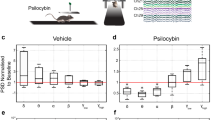Abstract
THERE are similarities between the behavioural effects of minor tranquillising drugs and those of lesions to the septal area and hippocampus1. Since the septal area contains the pacemaker cells for the hippocampal theta rhythm2, a parsimonious hypothesis to account for these common effects is that tranquillisers affect behaviour by altering septal control of this rhythm. Sodium amylobarbitone (SA) has been shown to block the behavioural effects of frustrative non-reward1, as do septal3 and hippocampal4 lesions. Rats exposed to non-reward in the runway show a characteristic hippocampal θ response at 7.7 Hz (ref. 1) (the θ frequency range in the rat is about 6–12 Hz). Higher and lower frequencies occur during forms of behaviour which are unaffected by the drug. It has therefore been proposed1 that the behavioural effects of SA arise by virtue of an impairment of septal control of the hippocampal θ rhythm specifically in a frequency band centred on 7.7 Hz. In support of this, it has been demonstrated5 that this drug raises the threshold for septal driving of the hippocampal θ rhythm selectively at 7.7 Hz, frequencies both above and below this value being minimally affected. Here we show that this kind of frequency-specific effect on septal driving of the hippocampal θ rhythm is also produced by other drugs with similar effects on behaviour1 (ethanol, chlordiazepoxide and Δ9-tetrahydro-cannabinol (Δ9-THC)), by drugs which impair noradrenergic neural transmission, and by destruction of the dorsal ascending noradrenergic bundle by intracerebral injection of 6-hydroxydopamine (6-OHDA)6.
This is a preview of subscription content, access via your institution
Access options
Subscribe to this journal
Receive 51 print issues and online access
$199.00 per year
only $3.90 per issue
Buy this article
- Purchase on Springer Link
- Instant access to full article PDF
Prices may be subject to local taxes which are calculated during checkout
Similar content being viewed by others
References
Gray, J. A., Psychol. Rev., 77, 465–480 (1970); in Handbook of Psychopharmacology (edit. by Iverson, L., Iversen, S. D., and Snyder, S. H.), (Plenum, New York, in the press).
Stumpf, Ch., Int. Rev. Neurobiol., 8, 77–138 (1965).
Dickinson, A., Physiol. Psychol., 2, 444–456 (1974).
Douglas, R. J., Psychol. Bull., 67, 416–442 (1967).
Gray, J. A., and Ball, G. G., Science, 168, 1246–1248 (1970).
Ungerstedt, U., Eur. J. Pharmacol., 5, 107–110 (1968); Acta physiol. scand., 82, Suppl. 367, 1–48 (1971).
Gray, J. A., Physiol. Behav., 8, 481–490 (1972).
Drewnowski, A., and Gray, J. A., Psychopharmacologia, 43, 233–237 (1975).
Anden, N. E., Corrodi, H., Dahlström, A., Fuxe, K. and Hökfelt, T., Life Sci., 5, 561–568 (1966).
Creveling, C. R., Daly, J., Tokuyama, T., and Witkop, B. Biochem. Pharmac., 17, 65–70 (1968).
Segal, M., and Landi, S. C., Brian Res., 82, 263–268 (1974).
Glowinski, J., and Iversen, L. L., J. Neurochem., 13, 655–669 (1966).
Cuello, A. C., Hiley, C. R., and Iversen, L. L., J. Nenmchem. 21, 1337–1340 (1973).
Lidbrink, P., Corrodi, H., Fuxe, K., and Olson, L., Brain Res., 45, 507–524 (1972).
Mason, S. T., and Iversen, S. D., Nature, 258, 422–424 (1975).
Author information
Authors and Affiliations
Rights and permissions
About this article
Cite this article
GRAY, J., MCNAUGHTON, N., JAMES, D. et al. Effect of minor tranquillisers on hippocampal θ rhythm mimicked by depletion of forebrain noradrenaline. Nature 258, 424–425 (1975). https://doi.org/10.1038/258424a0
Received:
Accepted:
Issue Date:
DOI: https://doi.org/10.1038/258424a0
This article is cited by
-
An improved human anxiety process biomarker: characterization of frequency band, personality and pharmacology
Translational Psychiatry (2015)
-
A comparison of the acute effects of a tricyclic and a MAOI antidepressant on septal driving of hippocampal rhythmical slow activity
Psychopharmacology (1994)
-
Na+/Na+ exchange and Na+/H+ antiport in rabbit erythrocytes: Two distinct transport systems
The Journal of Membrane Biology (1991)
-
The effects of compounds related to ?-aminobutyrate and benzodiazepine receptors on behavioural responses to anxiogenic stimuli in the rat: Punished barpressing
Psychopharmacology (1985)
Comments
By submitting a comment you agree to abide by our Terms and Community Guidelines. If you find something abusive or that does not comply with our terms or guidelines please flag it as inappropriate.



